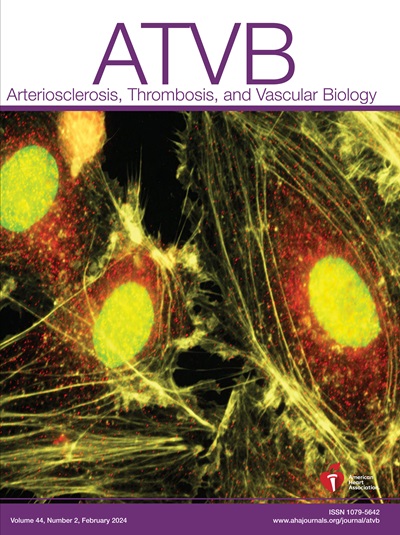类黄酮摄入量与亚临床动脉粥样硬化之间的关系:MESA.
IF 7.4
1区 医学
Q1 HEMATOLOGY
Arteriosclerosis, Thrombosis, and Vascular Biology
Pub Date : 2024-09-12
DOI:10.1161/atvbaha.124.321106
引用次数: 0
摘要
背景类黄酮可能在减轻动脉粥样硬化性心血管疾病方面发挥作用,有证据表明不同血管床的效果可能不同。目前还缺乏对动脉粥样硬化潜在风险不同的亚人群与动脉粥样硬化亚临床标志物之间关系的研究。方法在5599名MESA(多种族动脉粥样硬化研究)参与者中,使用重复测量模型研究了膳食类黄酮摄入量(通过食物频率问卷估算)与动脉粥样硬化亚临床指标(踝肱指数、颈动脉斑块和中层内膜厚度以及冠状动脉钙化)之间的关系。暴露和结果是在第 1 次检查(2000-2002 年)和第 5 次检查(2010-2011 年)时测量的。结果 在基线分析人群中,男性占46%,中位年龄为62岁(四分位距为53-70岁),类黄酮总摄入量为182毫克/天(四分位距为98-308毫克/天)。经过多变量调整后,总类黄酮摄入量最高(四分位数4)与最低(四分位数1)的参与者踝肱指数小于1的几率降低了26%(几率比为0.74 [95% CI, 0.60-0.92]),颈动脉斑块的几率降低了18%(几率比为0.82 [95% CI, 0.69-0.99]),这是考试1和考试5的平均值。黄酮醇、黄烷醇单体和花青素的中度(四分位数 3)至高度(四分位数 4)摄入量与踝肱指数<1 的几率降低 19% 至 34% 和颈动脉斑块的几率降低 18% 至 20% 相关。基线花青素摄入量最高(四分位数 4)的参与者的颈动脉斑块进展速度略低于中等摄入量(四分位数 2 和 3)的参与者。花青素与血管内膜厚度或冠状动脉钙化无明显关联。结论 在这一多种族人群中,膳食类黄酮摄入量越高,外周和颈动脉粥样硬化的几率越低。增加富含类黄酮的健康食品的摄入量可防止外周和颈动脉粥样硬化。本文章由计算机程序翻译,如有差异,请以英文原文为准。
Associations Between Flavonoid Intake and Subclinical Atherosclerosis: The MESA.
BACKGROUND
Flavonoids may play a role in mitigating atherosclerotic cardiovascular diseases, with evidence suggesting effects may differ between vascular beds. Studies examining associations with subclinical markers of atherosclerosis between subpopulations with different underlying risks of atherosclerosis are lacking.
METHODS
Among 5599 participants from the MESA (Multi-Ethnic Study of Atherosclerosis), associations between dietary flavonoid intakes (estimated from a food frequency questionnaire) and subclinical measures of atherosclerosis (ankle-brachial index, carotid plaques and intima-media thickness, and coronary artery calcification) were examined using repeated measures models. Exposures and outcomes were measured at exam 1 (2000-2002) and exam 5 (2010-2011). Stratified analyses and interaction terms were used to explore effect modification by time, sex, race/ethnicity, and smoking status.
RESULTS
In the analytic population, at baseline, ≈46% were males with a median age of 62 (interquartile range, 53-70) years and total flavonoid intakes of 182 (interquartile range, 98-308) mg/d. After multivariable adjustments, participants with the highest (quartile 4) versus lowest (quartile 1) total flavonoid intakes had 26% lower odds of having an ankle-brachial index <1 (odds ratio, 0.74 [95% CI, 0.60-0.92]) and 18% lower odds of having a carotid plaque (odds ratio, 0.82 [95% CI, 0.69-0.99]), averaged over exams 1 and 5. Moderate (quartile 3) to high (quartile 4) intakes of flavonols, flavanol monomers, and anthocyanins were associated with 19% to 34% lower odds of having an ankle-brachial index <1 and 18% to 20% lower odds of having carotid plaque. Participants with the highest intakes of anthocyanins (quartile 4) at baseline had a marginally slower rate of carotid plaque progression than those with moderate intakes (quartiles 2 and 3). There were no significant associations with intima-media thickness or coronary artery calcification. Observed associations did not differ by sex, race/ethnicity, or smoking status.
CONCLUSIONS
In this multi-ethnic population, higher dietary flavonoid intakes were associated with lower odds of peripheral and carotid artery atherosclerosis. Increasing intakes of healthy, flavonoid-rich foods may protect against atherosclerosis in the peripheral and carotid arteries.
求助全文
通过发布文献求助,成功后即可免费获取论文全文。
去求助
来源期刊
CiteScore
15.60
自引率
2.30%
发文量
337
审稿时长
2-4 weeks
期刊介绍:
The journal "Arteriosclerosis, Thrombosis, and Vascular Biology" (ATVB) is a scientific publication that focuses on the fields of vascular biology, atherosclerosis, and thrombosis. It is a peer-reviewed journal that publishes original research articles, reviews, and other scholarly content related to these areas. The journal is published by the American Heart Association (AHA) and the American Stroke Association (ASA).
The journal was published bi-monthly until January 1992, after which it transitioned to a monthly publication schedule. The journal is aimed at a professional audience, including academic cardiologists, vascular biologists, physiologists, pharmacologists and hematologists.

 求助内容:
求助内容: 应助结果提醒方式:
应助结果提醒方式:


